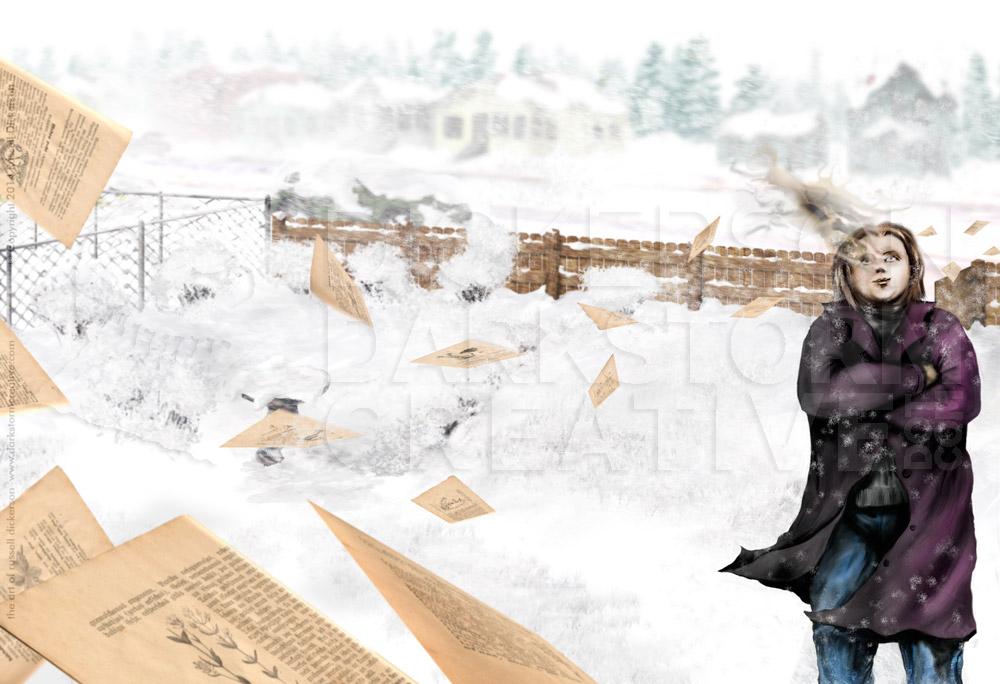As a freelance artist (and designer), the need to have a contract template available becomes apparent pretty quickly. I like to think I work hard as an artist, and I want my works to be taken care of and used in the proper manner. So, I did a bunch of research, read a lot of books and websites, and managed to cobble together a contract that works for me.
Should you always have a contract? Yes. Do I always have a contract? No (he says, sheepishly).

But it’s something that I’ve been trying to get better at, and I think it’s important for both parties to have one in place. At the very least, it gives you a professional expectation from both sides as to how to deal with art and its production.
There have been plenty of publishers (especially) that I don’t always contract with, for better or for worse. What’s worked for me may not work for you, and in fact I need to follow my own voice when I say that contracts are important to have.
Before we go any further though, I am not a lawyer. I’m an artist, and as such everything in this article should be taken with a grain of salt. It’s all based on legalities, from sources who do have lawyers that have reviewed their forms, and so on. But I’m just putting out there what I’ve used, it in no way represents what the laws in your area might be, so take the information I give you here as a start, and research the rest on your own.
I do not have all the answers, this is just what I use at the moment.
I’ve read dozens and dozens of contracts, agreements, websites, books, and other content about contracts, and they aren’t the easiest thing to get through. Don’t pass up a site that might be for a graphic designer and not an artist either, or even for a photographer. All of the visual disciplines, while maybe different in execution, often tread in the same waters.
Here are a few of the sources that I used, and I would very highly recommend starting there as well. Some of them are extremely detailed, others only vague inferences, but all were helpful in some way (and it’s just a partial list).
- The many books by Tad Crawford and Allworth Publishing are a great place to start, and they are books you can pick up online, in bookstores, and in lots of other places. They are very helpful and very extensive, and give you digital forms (often) to start with. They include Business and Legal Forms for Graphic Designers, The Artist-Gallery Partnership, Third Edition: A Practical Guide to Consigning Art, Legal Guide for the Visual Artist, and many others.
- The Graphic Artists Guild has a great page for their “Letter of Agreement”, which is much like a shortened contract. It’s a great place to start, check it out here.
- The American Institute of Graphic Arts (AIGA) has a very detailed, modular page for working with contracts and legalities. It’s a bit longwinded, but it also makes quite a lot of good points. See it here.
- This page on vintagephoto.com, by Jeremy Rowe, is a good reference from the photography side, but makes quite a lot of good points for other visual arts as well. It includes your possible rights in different situations, dealing with places that sell works, and a lot of other good information.
Mine’s probably not perfect, and it may even be flawed (though it is based fully on other contracts). I would love to have a discussion on what mine does and does not do, and maybe for all of the other artists that don’t have a contract ready this can be a good starting point.
One thing I will say too, this contract probably won’t work in every situation. In fact, I’ve seen a couple of situations already where it might not be perfect, and I’ve had to go back and edit it. It’s short enough that you can probably make it work though if needed, with a little editing.
From what I’ve seen since being an illustrator since the late 90’s, the contract needs to do a few things. It needs to protect your rights as an artist of course, so that your work is used as intended by those who license it or commission it. It also needs to protect your ability, as a business, to make money on your work and collect if that doesn’t work out as planned. As both an artist and a business, it also should strictly list what rights are being negotiated, how much time the contract covers, and other rights.
Don’t forget though, the contract protects the client as well, so don’t enter into one if you have no intention of doing the work. They want to see what they are getting in the contract, the delivery dates, and what they can use of your work and when. It’s only fair to see both sides of it, and as an artist to fully comply with what you agree to.
So, here goes. Here’s the text of the contract that I use, and it’s always a work in progress. It’s based very heavily on the Graphic Artist Guild’s Letter of Agreement, and reworked based on input from the other sources above (and many others as well).
The only thing you’re not getting here is my letterhead (well, it’s on the side, but same thing). On any contract you send, your unique letterhead should either be embedded in the document or printed out for signing. Also, any blanks that you see I just fill in for each client as I go.
Header (of a sort)
This section basically just lays out who we are, client and artist, and why we’re here.
This contract describes the relationship between _____________ (hereafter referred to as the Client), and Russell Dickerson (hereafter referred to as the Artist).
Artist’s Address: [no, I’m not adding it to the site] Email Address: [that you might be able to guess]
Client’s Address: ________________________ Email Address: _________________
Schedule
This section lays out when things are expected from both sides, but mostly the final art deadline. Basically, it’s the artist’s responsibility to get the work done before the deadline. It does make a note here that the client also needs to keep up on their end of the bargain, and it’s not the artist’s fault that things are late if the client drags their feet.
The Artist agrees to provide Final Art by ___________, and the Client agrees to approve or disapprove each stage of development in a timely manner. The Artist is not responsible for delays in completion of final art if approval times are not met.
Grant of Rights
Here, we’re going to lay out exactly what you’re giving as an artist. I like to be very specific here, in as much detail as possible. That way, if you create art for a postcard today, you don’t see it end up as a book cover tomorrow. It also becomes understood that if you create art for one version of a book, say, an ebook, they don’t have the license to just put the art on the hardcover, the trade paperback, their magazine, and so on. Those other things can be negotiated.
Now, that said, if they are going to use it for all of that just list it here. There’s nothing saying that this part is only about one thing or one project, it can cover several things. Just be clear what those are and the rights available. You can certainly go into First North American Rights, Exclusive rights, and so on, whatever is agreed upon.
The Client will have a worldwide, non-exclusive, unlimited license to display, distribute, and use the artwork, in whole or in part or in conjunction with the product listed below, including marketing and promotion of the product, per the terms of this contract. The Artist hereby grants to the Client the following rights to use the artwork:
For use as:_____________ For the product titled: _________ In the exclusive format:____________
Fee for Rights Granted and Production: $________
Terms
The terms area is where the legalese really takes off, and the business side of things. There are lots of other things that you could add that I don’t have here, like supplies costs, expenses, and such, but I haven’t needed those so far.
The reservation of rights covers any rights you didn’t talk about above, and protects you there. Having a revisions clause keeps people from taking advantage of you, and radically changing things mid-stream (because that’s never happened to me). The cancellation clause is important too, you don’t want to do a bunch of work only to see things cancelled. It does happen, projects get killed, but you should get something for the work you’ve already done.
The credits area makes sure that you are given proper credit in the work itself, which I think is very important. Even if it’s just a copyright line, it makes it a line item that it be included in the final work. Payment is one of the true legal-only parts of this, it’s like any business. I do the work, I want to get paid, and this is how I expect that to happen.
The original art clause doesn’t affect digital art of course, since there’s no real original. But it’s good to have in there anyway, just in case something does come up with files. If you do actual media-related art, like inks for example, then this part lets you keep those originals. If you know the art will be sent off for scanning, or if you have to lend it to the client for various reasons (like printing), then you probably should add more about insurance, protection of the piece, return times, and so on.
The permissions and miscellany sections really just sum up the legal side of things, and how things are to be dealt with if there are disputes.
Here’s the text of that section:
1) Reservation of Rights: All rights not expressly granted above are retained by the Artist, including any electronic rights or usage, and including, but not limited to, all rights in sketches, printing, comps or other preliminary materials. Any use additional to that expressly granted above requires arrangement for payment of a separate fee. Artist does not grant any reproduction rights for the artwork, in whole or in part, not used in the production of the format listed above. Use of approved sketches and other preliminary materials by Client for promotion of the listed product above is acceptable, provided artist credit is shown with all images, per this contract, and provided contract is not cancelled at any time.
2) Revisions: Revisions may be made only by the Artist at the sketch stage. Additional fees will be charged for revisions made after eight (8) sketches, and for revisions reflecting a new direction to the assignment, or new conceptual input.
3) Cancellation and Kill Fees: Cancellation (“kill”) fees are due based on the amount of work completed. Fifty percent (50%) of the final fee is due within 30 days of notification that for any reason the job is canceled or postponed before the final stage. One hundred percent (100%) of the total fee is due despite cancellation or postponement of the job if the art has been completed. Upon cancellation or kill all rights to the art revert to the Artist and all original art must be returned, including sketches, comps, or other preliminary materials.
4) Credits and Copies: A credit line suitable to the design of the page will be used. Client agrees to pay an additional fifty percent (50%) of the total fee, excluding expenses, for failure to include credit line. Credit line is required independent of Artist’s signature, which shall be included at Artist’s discretion unless otherwise agreed in writing above. Client agrees to provide Artist with one (1) sample copy of any produced material.
5) Payment: Payment for finished work is due upon acceptance, net thirty (30) days. The Client’s right to use the work is conditioned upon receipt of payment within thirty days of acceptance, and upon Client’s compliance with the terms of this agreement. A two percent (2%) monthly service charge will be billed against late payment.
6) Original Art: Original art remains the property of the Artist unless expressed in the agreement.
7) Permissions and Releases: The Client agrees to indemnify and hold the Artist harmless against any and all claims, costs, and expenses, including attorney’s fees, due to materials included in the Work at the request of the Client for which no copyright permission or privacy release was requested, or for which uses exceed the uses allowed pursuant to a permission or release.
8 ) Miscellany: This Agreement shall be binding upon the parties, their heirs, successors, assigns, and personal representatives. This Agreement constitutes the entire understanding of the parties. Its terms can be modified only by an instrument in writing signed by both parties, except that the Client may authorize expenses or revisions orally. No terms attached to any check for payment under this Agreement can modify the Agreement except under an independent instrument in writing signed by both parties. Any dispute regarding this agreement shall be arbitrated under the rules of the American Arbitration Association and the law. A waiver of a breach of any of the provisions of this Agreement shall not be construed as a continuing waiver of other breaches of the same or other provisions.
Signatures and final requirements
Of course there are the signatures at the bottom, it is a contract after all. The most important line though is the last one:
This Agreement must be signed and returned before Artist can schedule or begin this job.
That’s a great thing to have, and as the artist it can cover your ass if someone’s dragging things behind. It’s really a statement that you need all this to be official, that this is a business arrangement, and you won’t do anything at all until you have this back signed. It can separate those who are serious about doing business, and those who just want some project for various reasons. It’s up to you as the artist to stick with it though.
It should be noted again, I am in no way representing myself as a legal authority on this subject, and this article is for informational purposes only. Make sure you talk to your legal counsel.


